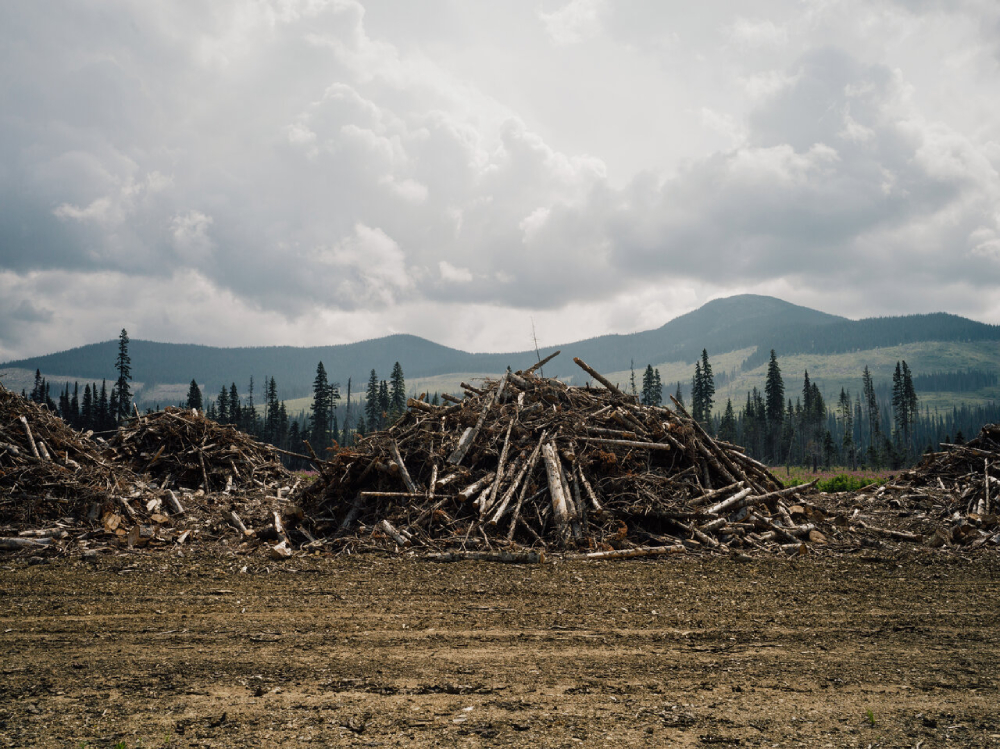British Columbia’s forestry watchdog is calling on the government to review its approach to old-growth logging around Prince George, saying biodiversity in the region may be at risk.
The B.C. Forest Practices Board report, released just before Christmas, is the result of a year-long investigation following an initially anonymous complaint by a government employee.
The board identified several concerns with the way government manages old forests in the Prince George timber supply area, the largest in the province, including its definition of old growth and use of outdated industry standards, which were last revised before the mountain pine beetle outbreak. It called on the province to update its objectives for old growth in partnership with Indigenous communities.
It’s a start, say those studying logging’s effect on old-growth forests in the province.
Judy Thomas was working as a stewardship forester with the Ministry of Forests, Lands, Natural Resource Operations and Rural Development when she filed the anonymous complaint with the Forest Practices Board. She said the news is a cause for celebration.
“They wrote a good report, and they really asked the ministry to get back to basics and redo their landscape order, so that is good,” said Thomas, who has since retired. “It hasn’t happened yet. We’re just at the words stage. However, the board carries a lot of weight and I believe that public opinion is changing.”
Thomas said she was alarmed by what she was seeing while working in the bush near her home in Prince George. On their own initiative, she and her husband, Rob Norwell, began researching the effects of increased forest harvest levels that were intended to reduce a spruce beetle outbreak that began in 2015.
Their study overlaid government data about spruce beetle-infected forests from 2014 to 2019 against cutblocks harvested within the same period.
It found a disconnect between the claimed objective of curbing the beetle’s spread and what was happening on the ground.
While logging was supposed to be focusing on salvaging dead timber that still held value and reducing the beetle infestations, Thomas said that wasn’t happening.
A document released this summer outlines the provincial chief forester’s priorities for spruce beetle reduction.
It says stands with greater than 50 per cent dead trees are the highest priority for logging and those with more than 30 per cent dead trees are moderate priority. Stands with less than 30 per cent dead trees were considered low or very low priority for logging.
In addition, the objectives focus on reducing the spread of the spruce beetle by logging forest stands where more than 10 per cent of trees have a live beetle infestation, also known as “attacked” trees.
However, Thomas said that aerial overview flights used by the province to determine the beetle’s spread only show dead or dying trees and don’t determine live beetle infestations.
In addition, her research showed that 70 per cent of the harvest in the Prince George TSA contained less than 10 per cent dead trees. In the entire district, 62 per cent of logging was in areas where there was no spruce beetle at all.
She said they typically saw two- or three-hectare clusters of infested trees — about one per cent — in a 200-hectare patch that had been logged.
“If you’ve got a spruce stand, and only 10 per cent of the stand has been affected, then there’s nothing wrong with that stand. It’s there for caribou, it’s there for fisher, it’s there for keeping streams clean, it’s there for future harvest,” said Thomas, who presented her findings through the University of Northern British Columbia this fall.

“The reality is, the extent of the beetle is much smaller than they’re saying. They are logging an awful lot of unattacked spruce. They’re making really big clearcuts [and] there’s insufficient monitoring by the ministry of forests.”
Thomas added that the current approach to managing spruce beetle is similar to — and repeats errors from — the mountain pine beetle epidemic, despite the pests’ differences. That presents a risk to both biodiversity and to mid-term timber supply, which could lead to further mill closures, she said.
“The mistake of the large clearcuts appears to be repeated. The mistake of letting them go after anything is repeated,” she said. “Old growth is a non-renewable value, and we don’t have very much left.”
Forest Practices Board chair Kevin Kriese said only about 10 per cent of the roughly 60 complaints the board receives each year results in an investigation, but that it currently has several other similar investigations happening elsewhere in the province.
“This reflects concern across other parts of the province around the management of old growth,” he said. “It’s one of the most important values and probably one of the most controversial issues in forestry today. So, we do get other complaints on this topic.”
Kriese said several things make the Prince George TSA unique. For one, its size. At roughly eight million hectares, it is more than twice the size of Vancouver Island. Of that, about 50 per cent is dominated by lodgepole pine that has been heavily impacted by wildfires and the mountain pine beetle infestation.
The area is also one of the few in the province where specific areas of protected old growth aren’t identified on maps of the timber supply area. Instead, the management plan sets out a percentage of the TSA that must be maintained, which can mean important areas can be logged, he said.
Because of the area’s complexity, the board’s investigation focused on whether logging in the TSA was in compliance with a legal order that established landscape biodiversity objectives for the area in 2004. While the investigation found that forestry companies were in compliance with the 16-year-old guidelines, it added that the province needs to update the order following impacts like fires and mountain pine beetle.
According to Karen Price, an independent ecologist whose research informed a panel reviewing B.C.’s approach to old growth earlier this year, the finding that the forest industry is complying with legal requirements for biodiversity protection is misleading.
In B.C., most interior forests, and specifically those within the Prince George area, are defined as old growth if they are more than 140 years old. That’s different from coastal ecosystems, where old forests are defined as more than 250 years.
That distinction allows companies to increase the harvest with the assumption that forests will recover within a shorter time period.
Price said the approach amounts to mathematical smoke and mirrors.
“The legal requirements are based on incorrect math,” she said. “They are meeting legal requirements — or close to — where legal requirements say two plus two equals five.”
She adds that while the board’s direction to government is a start, it’s nowhere near enough to recover biodiversity in a region heavily impacted by industry.
The province should implement all 14 of the independent panel’s recommendations, which were released in September, she said.
In particular, Price points to the panel’s second recommendation — immediately after greater Indigenous involvement — that prioritizes ecosystem health and resilience.
“The damage to ecological integrity in the Prince George TSA is extensive and undeniable,” Price said, emphasizing the high risk to biodiversity in the area. “It’s worse than ‘at risk.’ Already much has been lost — moose, grizzlies, marten, salmon populations have dropped precipitously.”
Also included in the panel’s recommendations, which the NDP promised to implement during the fall election campaign, are greater involvement of local communities, providing more information to the public and more robust monitoring — things that Thomas would have liked highlighted in the Forest Practices Board report.
“The board did say First Nations should be involved. Great, absolutely, but also the public should be involved — at the table, with their input,” she said. “It should be all public. It should be all on the web: the monitoring reports that happen, the recruitment strategies.”
“Recruitment strategies” are policies that let companies meet protection goals by counting stands that do not meet the old-forest definition but could contribute to long-term old-growth objectives.
The board’s report makes two recommendations to government. The first is to rectify shortcomings with old-growth mapping and “promptly” identify “old growth management areas where the immediate risks to old forest are the greatest.”
Secondly, it asks the province to review and update requirements for biodiversity in the region using First Nations partnerships, transparency and consideration for the implications of climate change on forest management.
“As old forests are depleted, the opportunities to address old forest contribution to biodiversity diminish,” the report concludes.
In an emailed statement, the Ministry of Forests, Lands, Natural Resource Operations and Rural Development said it will accept the board’s advice to review the current approach and ensure it reflects changes to the landscape, new information and current societal values.
“Our government understands that, for too long, there has been a divisive and patchwork approach to how old-growth forests were managed in our province. That’s why our government asked an independent panel to advise us on how we could do better when it comes to protecting our old forests,” it said, adding that it would work with Indigenous leaders, industry, labour and environmental organizations to determine the path forward.
The board has given the province until May 30 to respond. Kriese said it often gets a “mixed” response to complex policy recommendations.
“In this case, we provided a fair bit of time because it’s complicated. These are policy issues that they have to grapple with,” he said. “So, we’ll wait for the province to respond and then it’s up to them to decide to accept our recommendations or not, and to tell us what actions they plan to take.”
In the meantime, logging continues in the Prince George area under the existing regulations. ![]()
Read more: Local Economy, Environment
















Tyee Commenting Guidelines
Comments that violate guidelines risk being deleted, and violations may result in a temporary or permanent user ban. Maintain the spirit of good conversation to stay in the discussion.
*Please note The Tyee is not a forum for spreading misinformation about COVID-19, denying its existence or minimizing its risk to public health.
Do:
Do not: